Curious about where freelancing stands in 2025? You’re in the right place.
With more people choosing flexibility over the 9-to-5 grind, freelancing has become a serious career path—not just a backup plan.
But how many freelancers are there worldwide? Which jobs are the most in demand? And what kind of money are freelancers actually making these days?
In this guide, we’re diving into the key freelance statistics you need to know this year.
From who’s freelancing and where they’re working to how platforms like Fiverr and Upwork are performing, these numbers reveal just how fast this independent workforce is growing.
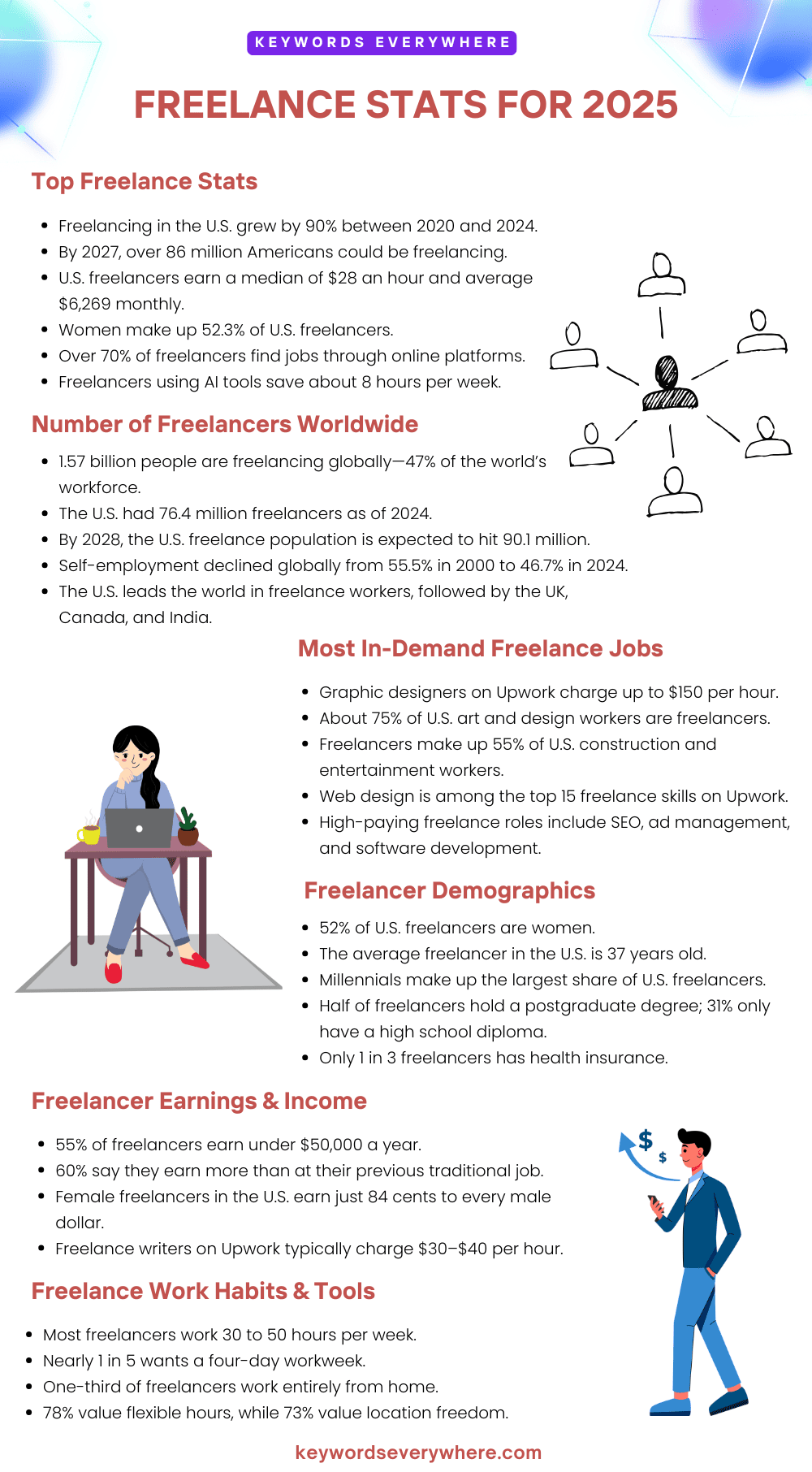
Top Freelance Stats
Freelancing is no longer just a side hustle or temporary fix—it’s now a major part of the global workforce, with millions of people choosing this path for the freedom and flexibility it offers.
From income trends to platform usage and work habits, the freelance world is full of powerful numbers that show just how much things have changed.
Below are the top freelance stats that give you a real sense of how big and influential freelancing has become in 2025.
1. The business process outsourcing market is growing fast—it was worth $315.2 billion in 2023 and is expected to hit $739.4 billion by 2033, growing steadily each year by nearly 9%.

Business Process Outsourcing Market
2. In the U.S., the number of people freelancing nearly doubled, up by 90%, between 2020 and 2024. If things continue this way, over 86 million Americans will be freelancing by 2027, making up more than half the country’s workforce.
3. When it comes to gender, 52.3% of freelancers are women, and 47.7% are men. But there’s still a big pay gap—women in the U.S. earn just 70 cents for every dollar men make for freelance work.
4. Freelancers in the U.S. charge a median rate of $28 an hour and make around $6,269 a month on average, though earnings can vary greatly depending on the type of work and experience.
5. Gen Z is jumping into freelancing in big numbers—52% of Gen Z professionals took on freelance work in 2024 alone, showing that younger workers are leaning heavily toward flexible careers.
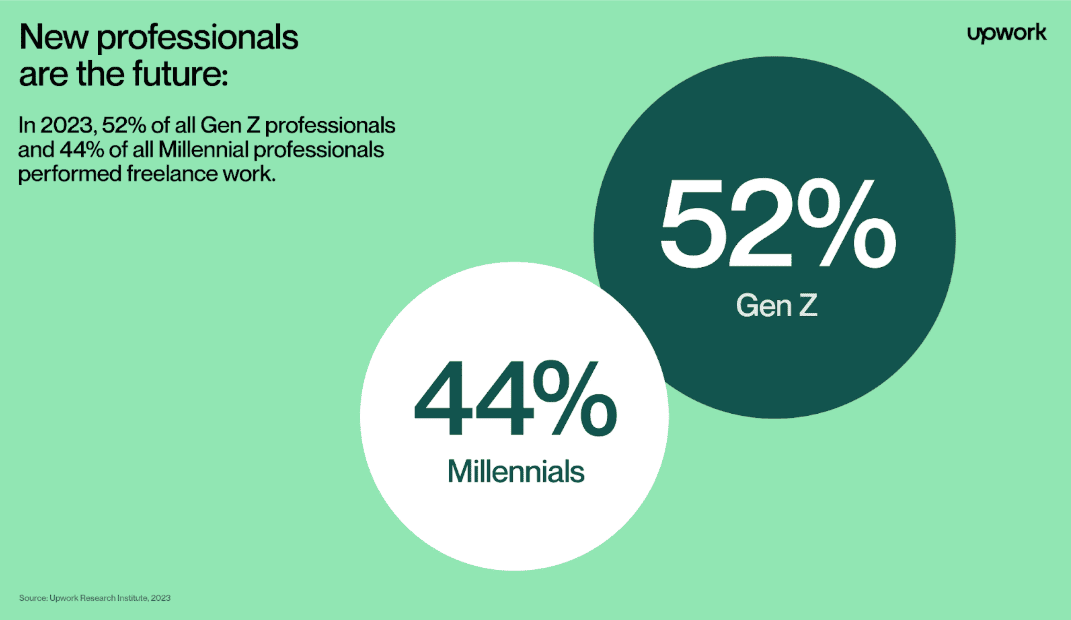
Gen Z makes the majority of freelancers
6. Most freelancers—over 70%—say they find jobs using online platforms and gig websites, which have become the main way people connect with clients and build their freelance careers.
7. Self-employment is going down. In 2000, about 55.5% of workers were self-employed, but by 2024, that number dropped to 46.7%—likely due to more structured freelance platforms and digital job systems.
8. Freelancers using AI tools save a lot of time—around eight hours a week. Across 2.76 million freelancers, that adds up to over 22 million hours saved every week, which is equal to about 10,748 full-time jobs.
9. About 70% of freelancers say they chose this path for a better work-life balance. Still, many aren’t happy with the benefits—61% report feeling dissatisfied with things like healthcare or retirement plans.
10. Data from Keywords Everywhere shows that freelance work is a hot topic online. Every month, around 368,000 people search for “freelance jobs” on Google, and related terms like “freelance work” and “freelance” also get a high number of searches.
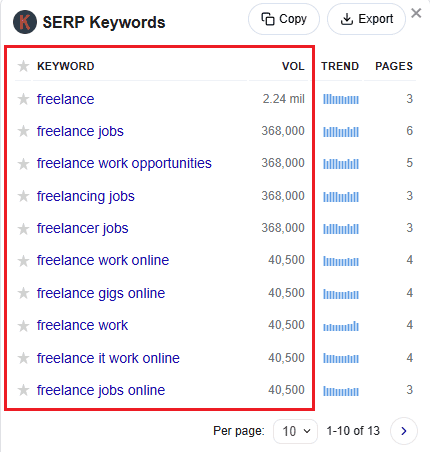
Number of Freelancers Worldwide
More people than ever before are stepping away from traditional jobs and choosing to work independently, whether full-time or part-time.
This shift is happening not just in the U.S., but all over the world, as technology makes it easier to work from anywhere.
Here are the freelance stats that show how many freelancers are out there globally, and how those numbers have grown over just the last few years.
11. There are around 1.57 billion freelancers worldwide today, meaning almost 47% of the global workforce is working independently instead of being tied to a traditional job.
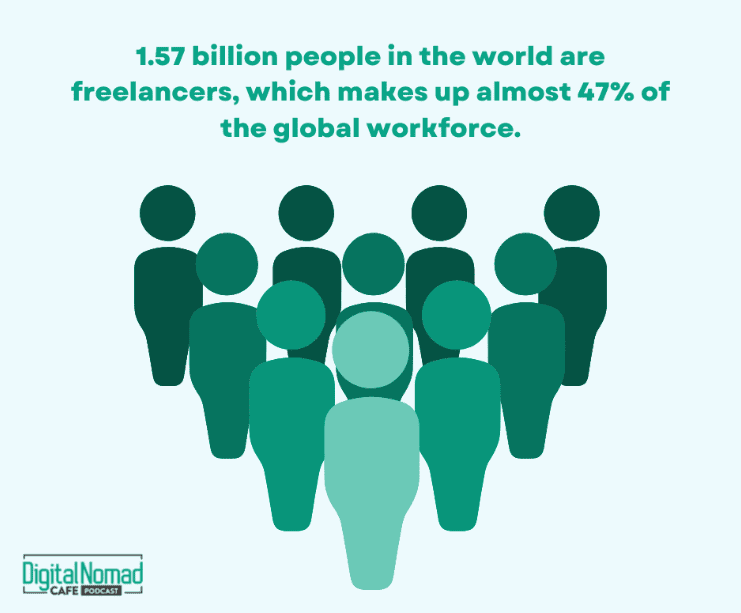
Number of freelancers worldwide
12. Even though that’s a huge number, the percentage of self-employed workers has actually gone down over time, from 55.5% back in 2000 to 46.7% in 2024, showing that while freelancing is growing in some areas, it’s shrinking in others.
13. As of 2025, the United States leads the world in the number of freelancers, followed by countries like the United Kingdom and Canada. India alone has about 15 million people working freelance jobs.
14. As of 2024, there are about 76.4 million freelancers in the United States, and that number has been growing steadily every single year—by at least 2 million more freelancers annually since 2017.
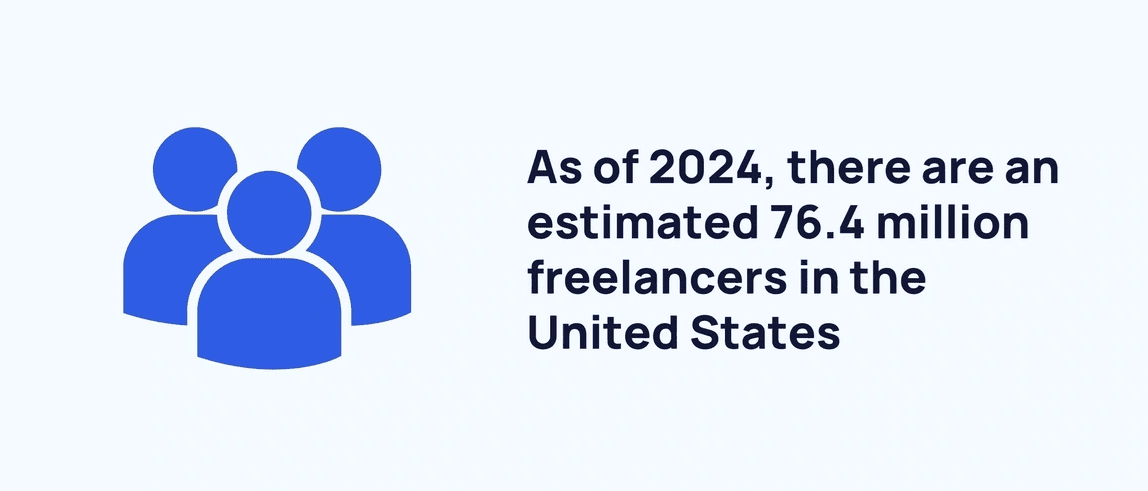
Number of freelancers in the US
15. And that number is still going up—by 2025, it’s expected to reach 79.6 million freelancers in the U.S., and by 2028, it could jump all the way to 90.1 million, showing how fast freelancing is growing across the country.
16. One report from Worksuite says that by 2027, half of the U.S. workforce could be freelancing, meaning more people may work independently than in regular full-time roles.
17. In the first half of 2024, U.S. companies were the biggest spenders when it came to hiring freelance talent, and surprisingly, companies in Ukraine came in second, showing how global demand for skilled freelancers continues to rise.
Most In-Demand Freelance Jobs
Some freelance jobs are seeing much higher demand than others, especially as businesses look for help in fast-growing areas like tech, AI, content, and marketing.
Trends in hiring and service searches are giving us a clear view of what skills are truly hot right now.
The following freelance stats reveal which freelance roles are currently leading the pack and attracting the most clients in 2025.
18. Content writing is still one of the most common freelance jobs out there, but when it comes to higher pay, graphic designers often come out ahead—some earn up to $150 an hour on Upwork.
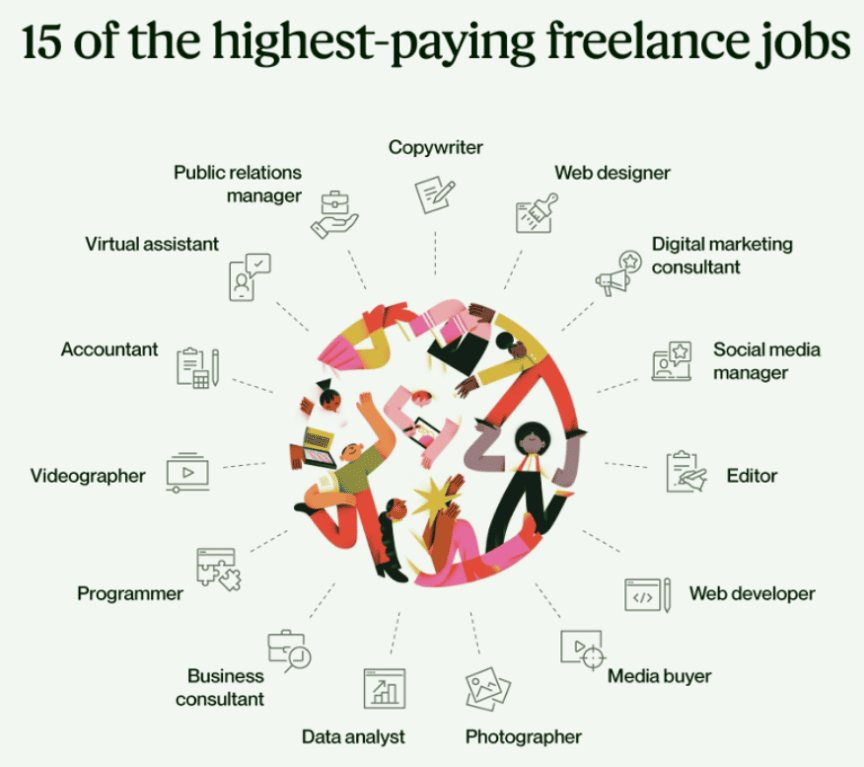
Highest-paying freelance jobs
19. In the U.S., most freelancers are working in creative fields, with around 75% of people in art and design freelancing, which shows just how dominant independent work has become in visually driven industries.
20. The entertainment world is also heavily freelance-based, with 55% of U.S. workers in that space choosing to work independently instead of under long-term contracts or company roles.
21. Construction might not be the first thing you think of when it comes to freelancing, but even in that field, about 55% of the workforce is made up of freelancers.
22. Web design has become one of the top 15 most in-demand freelance skills on Upwork, proving that businesses everywhere need help building and improving their online presence.
23. If you’re looking for the highest-paying freelance work, fields like SEO consulting, ad management, direct response copywriting, software development, and sales or lead generation top the list for earnings.
24. Right now, the most in-demand freelance skills include Instagram marketing, brand strategy, and anything to do with AI development.

Must have freelance skills
Freelancer Demographics
The freelance workforce includes people from all walks of life, but certain age groups, genders, and education levels are more represented than others, and that tells us a lot about who’s choosing to freelance and why.
Whether it’s younger professionals looking for flexibility or women outnumbering men in certain sectors, the makeup of this workforce is changing fast.
Here are the freelance stats that paint a clearer picture of who today’s freelancers really are.
25. Currently, 52% of all freelancers in the United States are women and 48% are men.
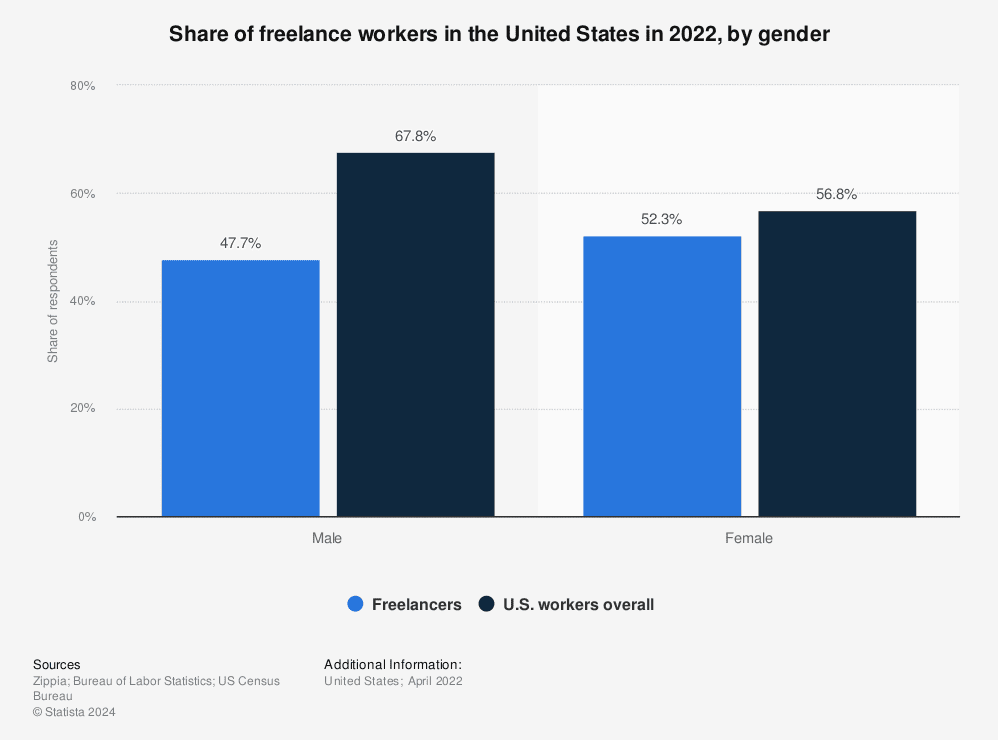
Freelance workers in the US by gender
26. The average freelancer in the U.S. is about 37 years old, but younger people are jumping in fast—more than half of workers aged 18 to 22 have freelanced before, while 40% of Millennials have too, making them the second most active age group in the space.
27. Even though only 40% of Millennials freelance, they still make up the largest share of all freelancers in the U.S., which means they’re leading the way when it comes to the size of the freelance workforce.
28. Education levels vary, but half of freelancers have earned postgraduate degrees. At the same time, about 31% entered freelancing with just a high school diploma, showing that formal education isn’t always a requirement to succeed.
29. Only around one-third of freelancers get health insurance through an employer, which is much lower compared to over 80% of traditional employees who have coverage, pointing to one of the biggest challenges in independent work.
30. About 78% of freelancers believe soft skills—like communication, time management, and problem-solving—are just as important as technical skills, showing how well-rounded you need to be to stay competitive.

Why soft skills matter more than ever
31. Over half of freelancers say they would rather trade their college education for hands-on technical training, especially when it comes to actually landing jobs and delivering real results.
32. Interestingly, 51% of freelancers say that no money could convince them to return to a traditional 9-to-5 job, which shows how much they value freedom, control, and flexible work.
Freelancer Earnings and Income Stats
How much freelancers earn depends on many things, like the kind of work they do, where they live, and how many hours they put in.
Some freelancers are making more than they would at a regular job, while others use it as a way to supplement their income.
Below are the freelance stats that break down how much money freelancers are actually making in 2025:
33. On average, female freelancers in the U.S. make about 84 cents for every dollar a male freelancer makes.
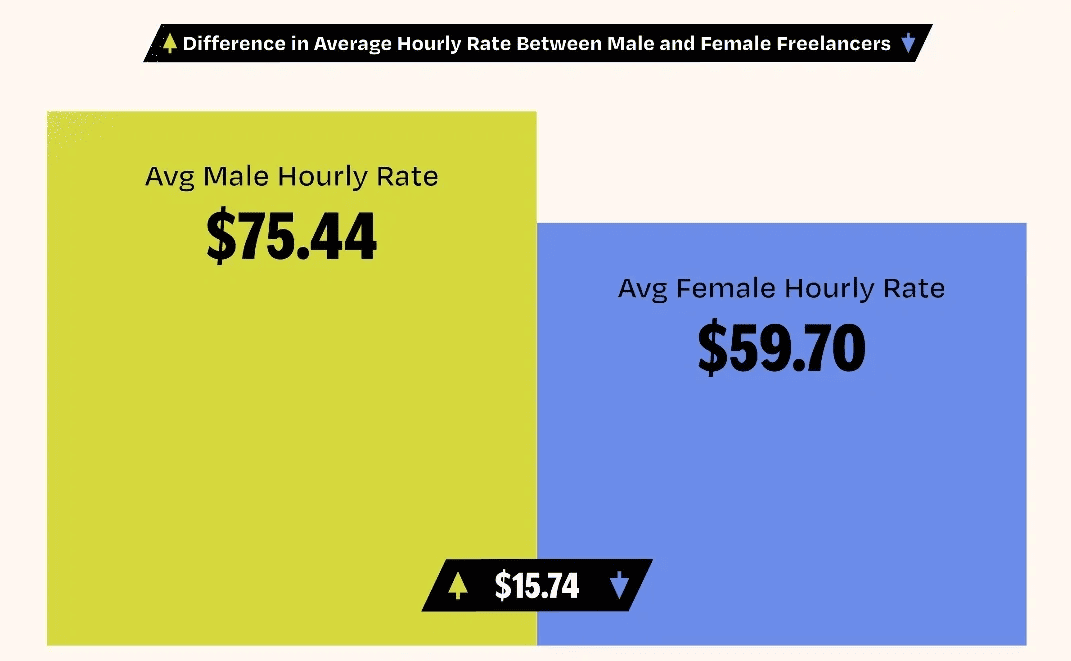
Difference in average hourly rate of male and female freelancers
34. 55% of all freelancers make less than $50,000 a year, while 42% earn $50,000 or more, which shows a wide range of income levels depending on your skills, experience, and industry.
35. Half of all freelancers have dealt with not getting paid on time—or not getting paid at all—at some point in their careers, which continues to be one of the biggest risks of working independently.
36. Freelance writers on platforms like Upwork usually charge between $30 and $40 an hour, which adds up to an average yearly income of about $42,000. However, in rare cases, top-tier copywriters with specialized skills can charge as much as $250 an hour.
37. For 60% of freelancers, quitting a traditional job led to better pay, proving that going solo can be a smart move financially when the right clients and opportunities are in place.
38. Freelancers in the U.S. earn an average of $6,269 monthly after expenses.
39. Most freelancers—83%—say they’re happy with what they’re earning, and around 75% feel good about the future.

Freelancers are happy with what they make
40. When deciding whether to take a project, 73% of freelancers say the hourly rate is one of the biggest things they look at.
41. Even though social media is everywhere, only 10% of freelancers use it to find work, while a much larger group—71%—get their gigs through online marketplaces like Upwork, Fiverr, and more.
Freelance Work Habits Stats
Freelancers enjoy the freedom to decide their schedules, but that doesn’t mean they’re working less—or that their routines all look the same.
Some work part-time while others work full-time or more to meet deadlines and keep clients happy.
Here are the freelance stats that show how many hours freelancers are working, how often, and what kind of balance they’re trying to maintain.
42. Most freelancers are putting in between 30 and 50 hours each week, which shows that even though they might not be working a traditional job, they’re still committing serious time to their craft and clients.
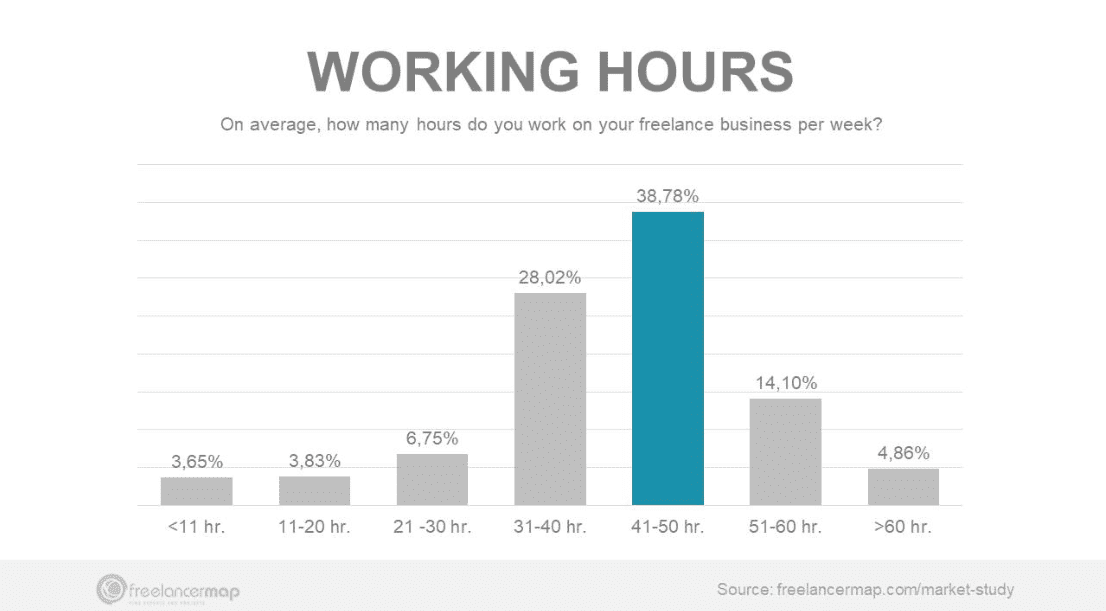
Freelancers working hours per week
43. When asked about the idea of a four-day workweek, nearly 1 in 5 freelancers said they would love to take three days off each week, which shows how much they value building a schedule that gives them more personal time.
44. Around one-third of freelancers work entirely from home, and together they make up nearly half of all remote workers today, showing just how strongly freelancing is tied to the growing trend of working from anywhere.
45. Among highly skilled freelancers who work remotely, 78% say the biggest reason they choose this lifestyle is the freedom to set their hours, while 73% are equally drawn to working from wherever they want and feeling more purpose in the projects they take on.
Top Freelance Platforms Stats
Online freelance platforms have become the go-to places for independent workers to find jobs, build reputations, and grow their businesses.
Each platform has its own strengths, and some are growing faster than others in terms of users and project volume.
The following freelance stats show how much business is happening through sites like Upwork, Fiverr, and Freelancer.com.
46. With more than 18 million registered users, Upwork is the world’s largest freelance platform as of 2025.
47. Upwork takes a cut from freelancers’ earnings through a sliding service fee that ranges between 5% and 20%, depending on how much the freelancer earns with a client over time.
48. According to data from Keywords Everywhere, Upwork’s website brings in more than 1.5 million visits each month.
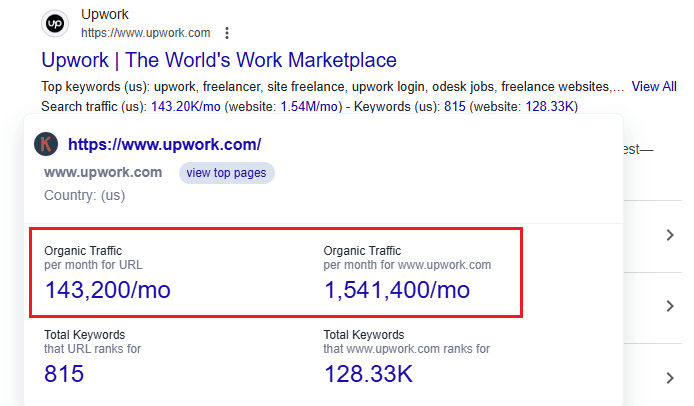
49. Freelancer.com, which is especially popular in India, gets over 105,000 monthly visits and features more than 1,800 different types of freelance jobs.
50. Ethereum-related work on Freelancer.com has seen a massive rise, with projects in this category increasing by 335%.
51. Fiverr pulled in $107.2 million in revenue in Q1 of 2025, up from $93.5 million during the same period in 2024, which marks a strong 14.6% year-over-year growth that reflects the growing demand for gig-based services.
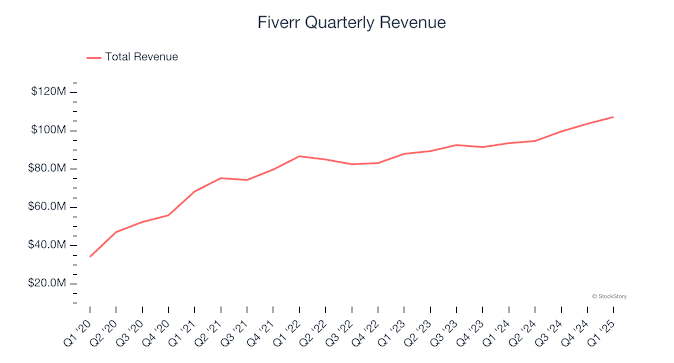
Fiverr revenue 2025
52. Right now, there are over 3 million active sellers on Fiverr, making it one of the most crowded and competitive freelance marketplaces online.
53. Fiverr’s website gets more than 616,000 visits each month, and with over 550 different service categories and buyers across more than 160 countries, it’s become a truly global platform for freelance work.
Global Freelancing Trends and Future Outlook
Freelancing is not just popular right now—it’s part of a long-term shift in how people work, with new technologies and attitudes shaping what’s next.
From AI-related jobs to international market growth, big changes are happening in the way freelance work is being done and valued.
Here are the freelance stats that reveal where freelancing is heading in the near future and what trends are already taking shape in 2025.
54. Gen Z is quickly reshaping the future of work, and by 2030, they’re expected to make up 30% of the U.S. workforce, with a strong preference for freelancing over traditional full-time roles.
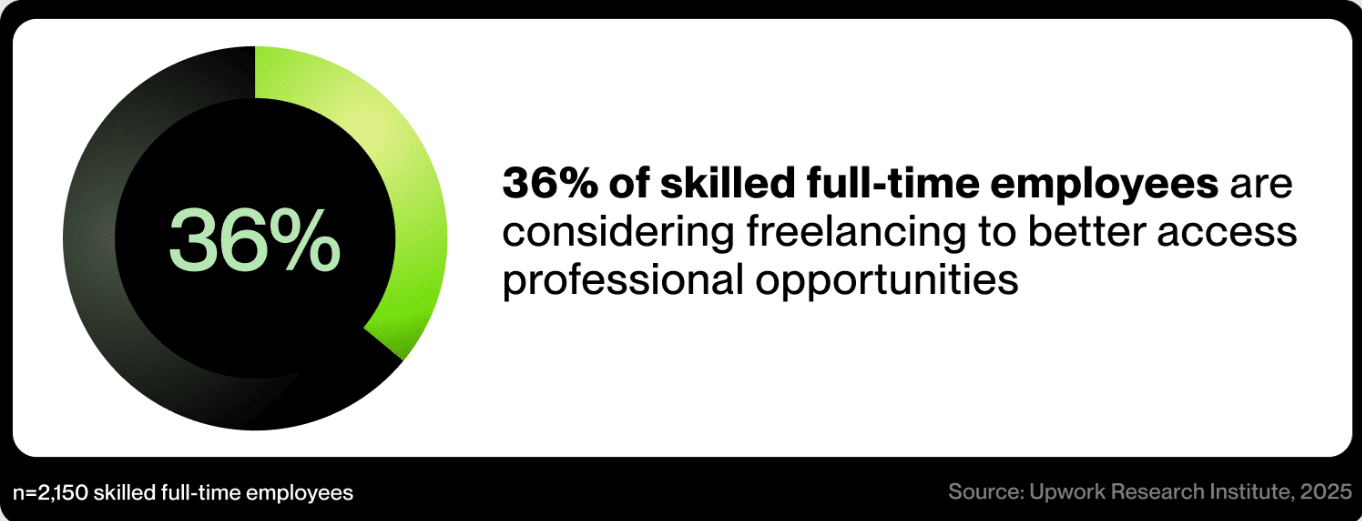
Full-time employees will consider freelancing in future
55. A large majority of skilled freelancers—84% to be exact—believe the best is still to come for the freelance economy, and even 77% of full-time employees agree that freelancing has a bright future ahead.
56. Freelancers feel far more optimistic than full-time workers, with 82% saying there are more opportunities for them now than a year ago. In comparison, only 63% of full-time employees feel the same, and 88% of skilled freelancers also believe their skills are in higher demand than ever.
57. A new kind of worker is emerging—the AI-Enabled Freelancer—who blends personal expertise with AI tools, and this group now makes up 31% of all skilled freelancers, while 36% say they expect to work this way within the next five years.
58. The World Economic Forum reports that 39% of today’s skills will be outdated or replaced within five years, meaning freelancers must keep learning and adapting to stay relevant.
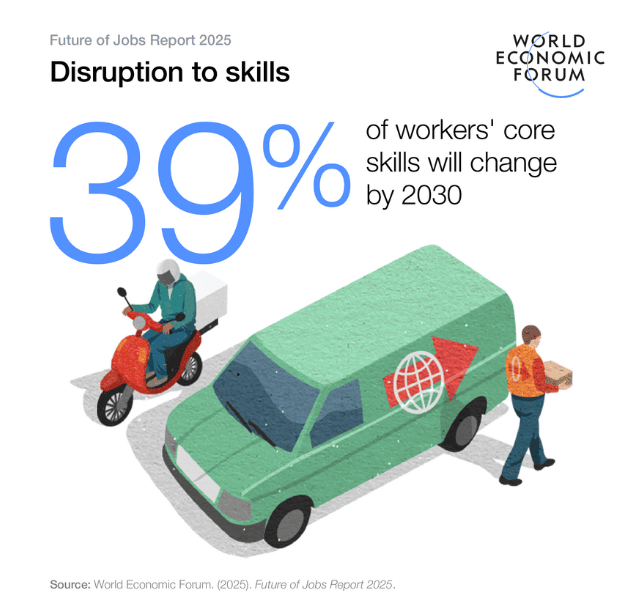
Core skills will change by 2030
59. A strong 64% of freelancers say no amount of money could convince them to go back to the regular 9-to-5 lifestyle.
60. Even those not freelancing today are considering the switch, with 59% of non-freelancers saying they will likely take on freelance work.
Conclusion
Freelancing is growing fast and changing the way people think about work, with millions of professionals turning to it for more control, better income, or the chance to work on what they love.
The freelance stats you’ve seen throughout this article tell a powerful story about where freelancing is today and where it’s going next.
As this shift continues, keeping up with the latest numbers will be key for freelancers and businesses alike.


